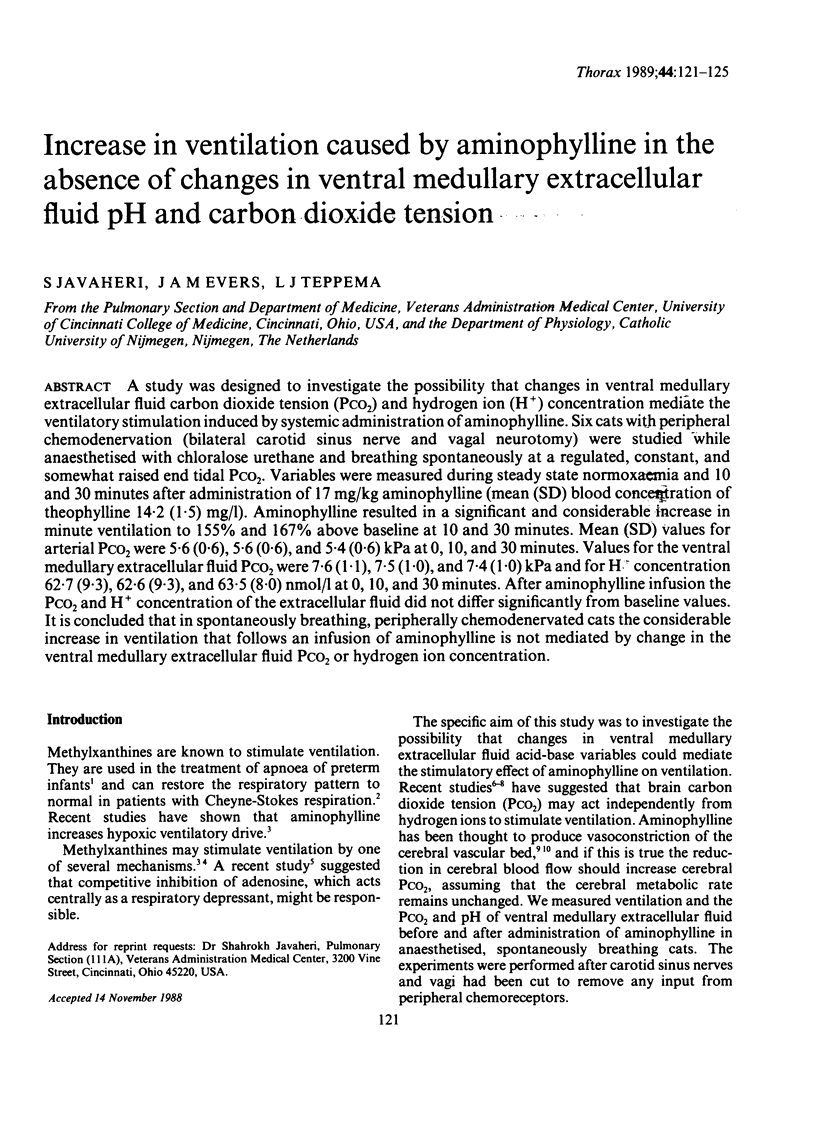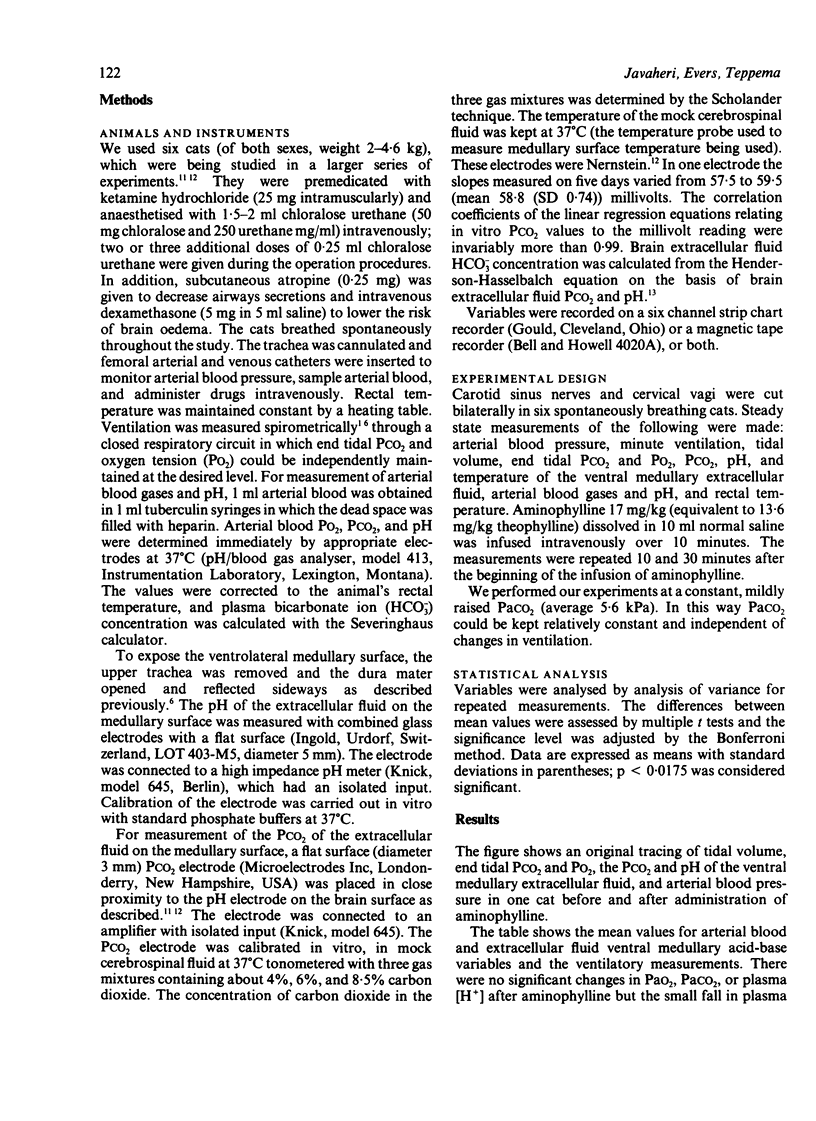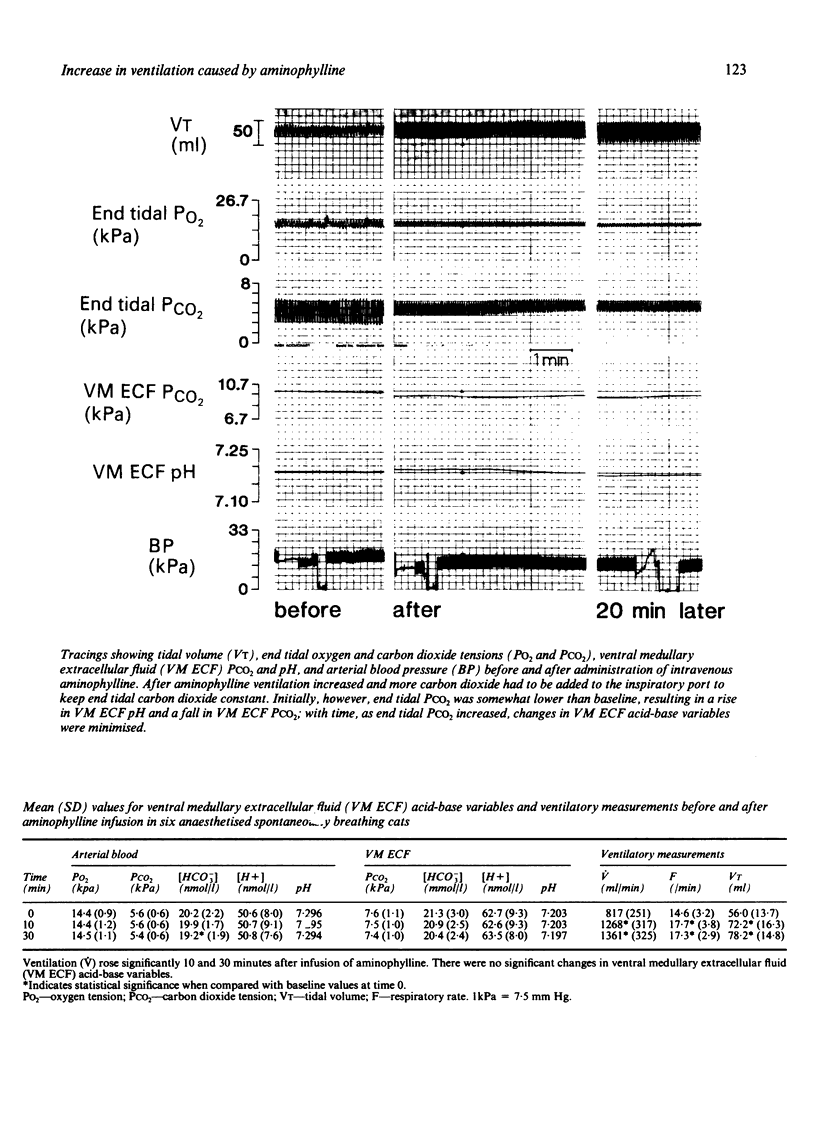Abstract
A study was designed to investigate the possibility that changes in ventral medullary extracellular fluid carbon dioxide tension (PCO2) and hydrogen ion (H+) concentration mediate the ventilatory stimulation induced by systemic administration of aminophylline. Six cats with peripheral chemodenervation (bilateral carotid sinus nerve and vagal neurotomy) were studied while anaesthetised with chloralose urethane and breathing spontaneously at a regulated, constant, and somewhat raised end tidal PCO2. Variables were measured during steady state normoxaemia and 10 and 30 minutes after administration of 17 mg/kg aminophylline (mean (SD) blood concentration of theophylline 14.2 (1.5) mg/l). Aminophylline resulted in a significant and considerable increase in minute ventilation to 155% and 167% above baseline at 10 and 30 minutes. Mean (SD) values for arterial PCO2 were 5.6 (0.6), 5.6 (0.6), and 5.4 (0.6) kPa at 0, 10, and 30 minutes. Values for the ventral medullary extracellular fluid PCO2 were 7.6 (1.1), 7.5 (1.0), and 7.4 (1.0) kPa and for H+ concentration 62.7 (9.3), 62.6 (9.3), and 63.5 (8.0) nmol/l at 0, 10, and 30 minutes. After aminophylline infusion the PCO2 and H+ concentration of the extracellular fluid did not differ significantly from baseline values. It is concluded that in spontaneously breathing, peripherally chemodenervated cats the considerable increase in ventilation that follows an infusion of aminophylline is not mediated by change in the ventral medullary extracellular fluid PCO2 or hydrogen ion concentration.
Full text
PDF




Images in this article
Selected References
These references are in PubMed. This may not be the complete list of references from this article.
- Aranda J. V., Turmen T. Methylxanthines in apnea of prematurity. Clin Perinatol. 1979 Mar;6(1):87–108. [PubMed] [Google Scholar]
- Eldridge F. L., Kiley J. P., Millhorn D. E. Respiratory responses to medullary hydrogen ion changes in cats: different effects of respiratory and metabolic acidoses. J Physiol. 1985 Jan;358:285–297. doi: 10.1113/jphysiol.1985.sp015551. [DOI] [PMC free article] [PubMed] [Google Scholar]
- Eldridge F. L., Millhorn D. E., Kiley J. P. Antagonism by theophylline of respiratory inhibition induced by adenosine. J Appl Physiol (1985) 1985 Nov;59(5):1428–1433. doi: 10.1152/jappl.1985.59.5.1428. [DOI] [PubMed] [Google Scholar]
- Eldridge F. L., Millhorn D. E., Waldrop T. G., Kiley J. P. Mechanism of respiratory effects of methylxanthines. Respir Physiol. 1983 Aug;53(2):239–261. doi: 10.1016/0034-5687(83)90070-1. [DOI] [PubMed] [Google Scholar]
- Gottstein U., Paulson O. B. The effect of intracarotid aminophylline infusion on the cerebral circulation. Stroke. 1972 Sep-Oct;3(5):560–565. doi: 10.1161/01.str.3.5.560. [DOI] [PubMed] [Google Scholar]
- Hedner T., Hedner J., Wessberg P., Jonason J. Regulation of breathing in the rat: indications for a role of central adenosine mechanisms. Neurosci Lett. 1982 Nov 30;33(2):147–151. doi: 10.1016/0304-3940(82)90242-7. [DOI] [PubMed] [Google Scholar]
- Javaheri S., Clendening A., Papadakis N., Brody J. S. Changes in brain surface pH during acute isocapnic metabolic acidosis and alkalosis. J Appl Physiol Respir Environ Exerc Physiol. 1981 Aug;51(2):276–281. doi: 10.1152/jappl.1981.51.2.276. [DOI] [PubMed] [Google Scholar]
- Javaheri S., Teppema L. J., Evers J. A. Effects of aminophylline on hypoxemia-induced ventilatory depression in the cat. J Appl Physiol (1985) 1988 May;64(5):1837–1843. doi: 10.1152/jappl.1988.64.5.1837. [DOI] [PubMed] [Google Scholar]
- Javaheri S., Teppema L. J. Ventral medullary extracellular fluid pH and PCO2 during hypoxemia. J Appl Physiol (1985) 1987 Oct;63(4):1567–1571. doi: 10.1152/jappl.1987.63.4.1567. [DOI] [PubMed] [Google Scholar]
- Lagercrantz H., Yamamoto Y., Fredholm B. B., Prabhakar N. R., von Euler C. Adenosine analogues depress ventilation in rabbit neonates. Theophylline stimulation of respiration via adenosine receptors? Pediatr Res. 1984 Apr;18(4):387–390. doi: 10.1203/00006450-198404000-00018. [DOI] [PubMed] [Google Scholar]
- Phillis J. W., Kostopoulos G. K., Limacher J. J. A potent depressant action of adenine derivatives on cerebral cortical neurones. Eur J Pharmacol. 1975 Jan;30(1):125–129. doi: 10.1016/0014-2999(75)90214-9. [DOI] [PubMed] [Google Scholar]
- Shams H. Differential effects of CO2 and H+ as central stimuli of respiration in the cat. J Appl Physiol (1985) 1985 Feb;58(2):357–364. doi: 10.1152/jappl.1985.58.2.357. [DOI] [PubMed] [Google Scholar]
- Snyder S. H., Katims J. J., Annau Z., Bruns R. F., Daly J. W. Adenosine receptors and behavioral actions of methylxanthines. Proc Natl Acad Sci U S A. 1981 May;78(5):3260–3264. doi: 10.1073/pnas.78.5.3260. [DOI] [PMC free article] [PubMed] [Google Scholar]
- Teppema L. J., Barts P. W., Evers J. A. Effects of metabolic arterial pH changes on medullary ecf pH, csf pH and ventilation in peripherally chemodenervated cats with intact blood-brain barrier. Respir Physiol. 1984 Oct;58(1):123–136. doi: 10.1016/0034-5687(84)90050-1. [DOI] [PubMed] [Google Scholar]
- WECHSLER R. L., KLEISS L. M., KETY S. S. The effects of intravenously administered aminophylline on cerebral circulation and metabolism in man. J Clin Invest. 1950 Jan;29(1):28–30. doi: 10.1172/JCI102230. [DOI] [PMC free article] [PubMed] [Google Scholar]
- Weyne J., Van Leuven F., Leusen I. Brain amino acids in conscious rats in chronic normocapnic and hypocapnic hypoxemia. Respir Physiol. 1977 Nov;31(2):231–239. doi: 10.1016/0034-5687(77)90105-0. [DOI] [PubMed] [Google Scholar]



